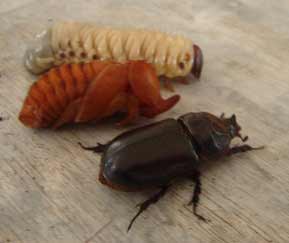- Rhinoceros beetle
----
Taxobox
name = Rhinoceros beetle

image_width = 240px
image_caption = Rhinoceros beetle, "Aegopsis curvicornis"

image_width = 240px
image_caption = Three stages from larva to adult'
regnum =Animal ia
phylum =Arthropod a
classis =Insect a
ordo =Coleoptera
familia =Scarabaeidae
subfamilia = Dynastinae
subfamilia_authority = MacLeay,1819
subdivision_ranks = Tribes
subdivision = 6-8, see textThe rhinoceros beetles or rhino beetle are a subfamily (Dynastinae) of
beetle s in the family ofscarab beetle s (Scarabaeidae). They are among the largest of beetles, and their common name refers to the characteristic horns borne by the males of most species in the group. The male beetles use their horns in mating battles against other males.Their larval stage is long, several years in some species. The larvae feed on rotten wood while the adults feed on nectar, plant sap and fruit. Rhinoceros beetle larvae are sometimes fried and eaten as a bush delicacy. Rhinoceros beetles are popular children's pets in Asia. They are clean, easy to maintain, and safe to handle. In Asian countries, male beetles are also used for gambling fights since they naturally compete for female beetles with the winner knocking the other off a log.
Rhinoceros beetles are also the strongest animals on the planet in relation to their own size. They can lift up to 850 times their own weight. [http://nationalzoo.si.edu/Animals/AnimalRecords/] To put this into perspective, if a human of average height and weight had the strength of the rhinoceros beetle, it would be able to lift a 65 ton object (e.g. an
M1 Abrams tank).ystematics and selected taxa
Well-known
species of rhino beetles include theAtlas Beetle ("Chalcosoma atlas"),Elephant Beetle ("Megasoma elephas"),European Rhinoceros Beetle ("Oryctes nasicornis"),Hercules Beetle ("Dynastes hercules"),Ox Beetle ("Strategus aloeus"),Unicorn Beetle ("Dynastes tityus") and "Megaceras briansaltini ".The rhino beetle tribes with some selected
genera are:Agaocephalini ** "
Aegopsis "Cyclocephalini Dynastini ** "
Allomyrina " Arrow, 1911
** "Chalcosoma " (includingAtlantase )
** "Dynastes " (includingSatanix )
** "Eupatorus " Burmeister, 1847
** "Golofa "
** "Megasoma " Kirby, 1825
** "Pachyoryctes " Arrow, 1908
** "Xylotrupes " Hope, 1837
**Goldsterus Oryctini ** "
Coelosis " Hope, 1837
** "Heterogomphus " Burmeister, 1847
** "Megaceras " Hope, 1837
** "Oryctes " Illiger, 1798
** "Strategus" Hope, 1837
** "Trichogomphus " Burmeister, 1847Oryctoderini Pentodontini ** "
Bothynus " Hope, 1837Phileurini ** "
Homophileurus " Kolbe, 1910
** "Phileurus " Latreille, 1807
* "incertae sedis "
** "Pericoptus " Burmeister, 1847Hexodontini **
Hexodon External links
* [http://www.naturalworlds.org/scarabaeidae/index.htm Family SCARABAEIDAE]
* [http://www.articlesextra.com/beetle-fight-xylotrupes-thailand.htm Information and photos of rhinoceros beetle gambling fights in Asia]
* [http://www.insectaculture.com/dynastiphoto.htm Photos]
* [http://www.goliathus.com/en/en-dynastidae.html Photos]
* [http://www.goliathus.cz/en/museum-dynastidae-4.html Photos]
Wikimedia Foundation. 2010.
